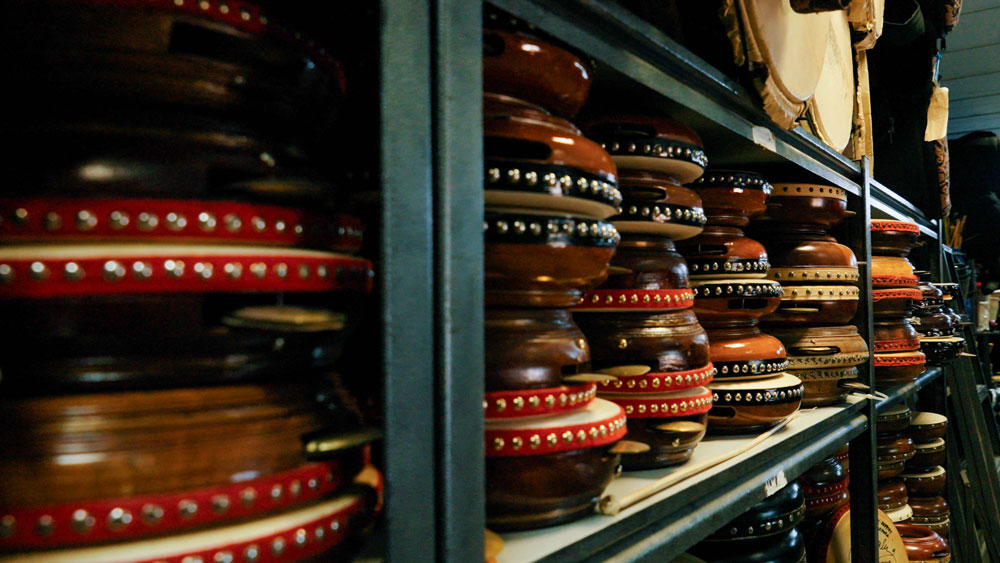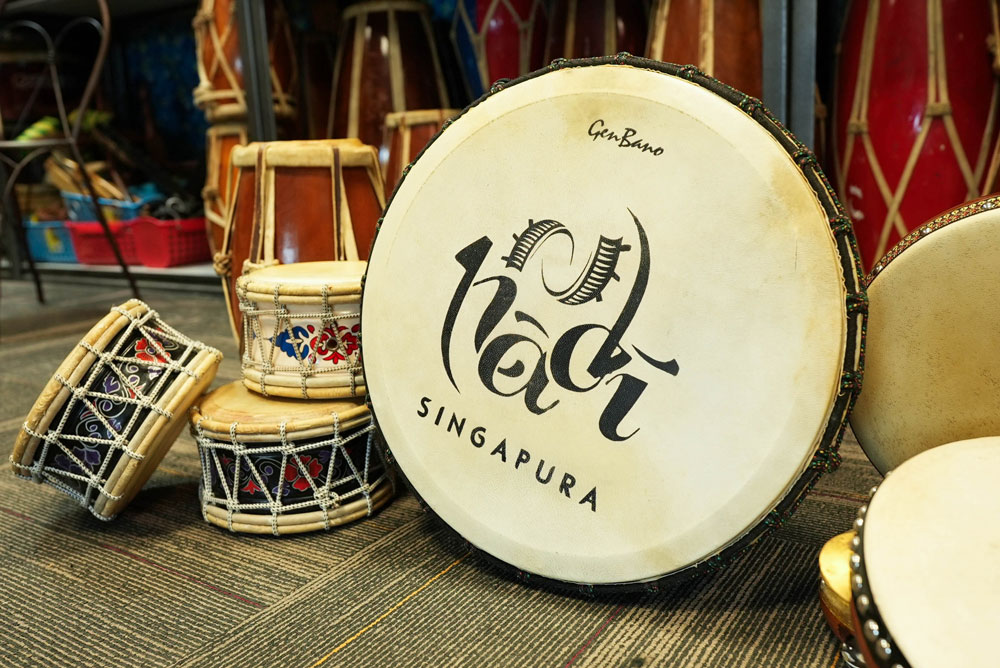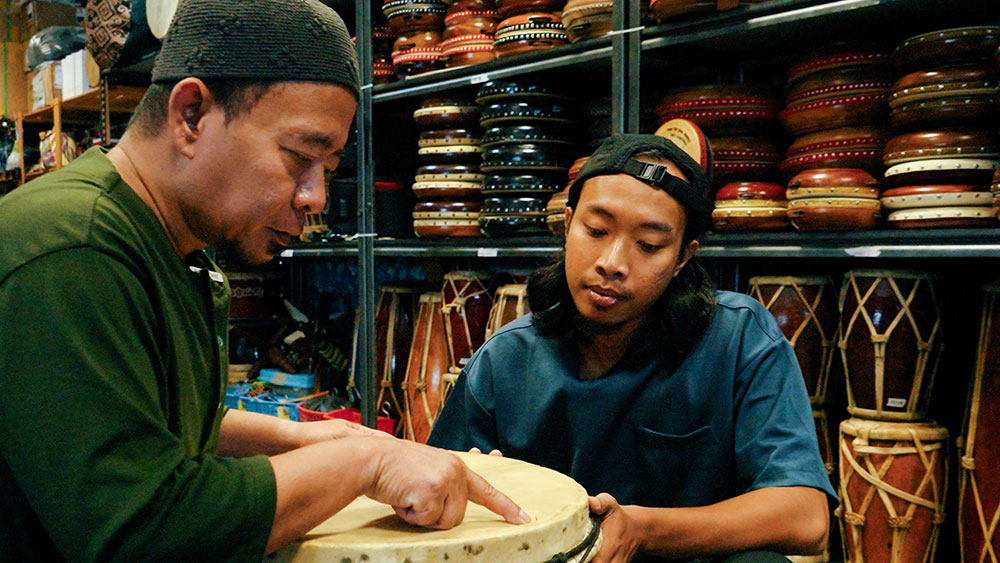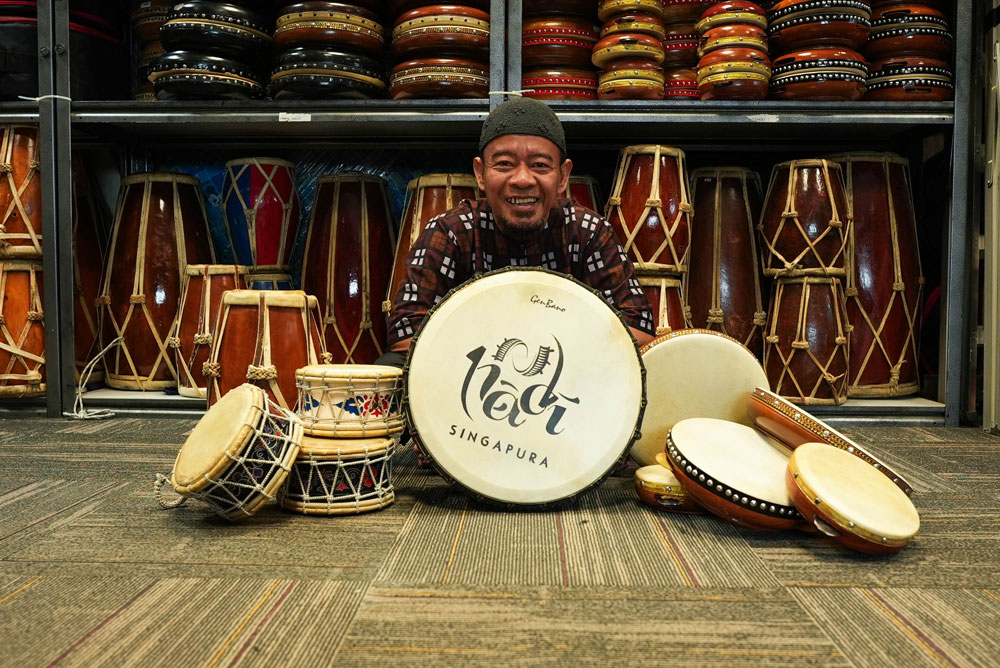TL;DR
The kompang that we usually see during weddings and festive occasions is only one type of many Malay drums! Why is the Malay drum important to the Malay community, and how does traditional Malay drum making remain relevant in today’s modern time and space? Yaziz Hassan, a drum maker and expert, enlightens us on these issues!
Yaziz Hassan is a renowned percussionist and Co-founder/Managing Director of the Malay drum ensemble, Nadi Singapura. He is also a player of the traditional Malay drum (gendang), specifically drums that are played by the hands, as well as a drum maker who repairs drums, like the rebana, jidur, marwas and more.
Yaziz’s first exposure to the gendang was when he volunteered to be a gendang player in a dikir barat performance. From that experience, the tone, beat and rhythm of the music produced by the gendang caught his attention. Since then, his mother would bring him to different events where there were rock bands, traditional music groups as well as dikir barat performances. As he attended these performances, the uniqueness of the Malay drums began to pique his interest.
His journey in drum making and maintenance began when the skin of his own drum tore during a visit to Pekanbaru, Riau, in 1997. He had to seek the assistance of a drum maker, whom Yaziz remembers as Pak Din. Pak Din had repaired his drum as if it was new and this left him in awe. This incident struck him. Yaziz knew that as a Malay drum player, he also needed to know how to care and maintain these drums.
To increase his knowledge in drum making and repair, Yaziz has attended various traditional music festivals such as in Medan and in Riau through the years to meet different drum masters.
The Malay Drum is More Than Just an Instrument
Today, only a few types of the Malay drums are known, like the kompang, hadrah and the rebana, even though there are more than 30 types of Malay drums. The presence of these Malay drums at weddings, religious ceremonies and Malay festivals show how deeply embedded they are in the social and cultural fabric of the Malay community.

These Malay drums are not merely musical instruments, but also symbols of cultural and communal identity as well as social cohesion. Yaziz emphasizes on how Malay drums like the rebana are instruments that require coordination among performers, as they are usually played as a group. Hence, there has to be a level of unity and synchronisation when playing the Malay drums. This incidentally also reflects the Malay identity of togetherness and of helping one another. When playing the rebana, the group of percussionists need to identify and have acute awareness of one another’s beat. No one plays his own rhythm and beat without the consideration of other rebana percussionists around him. Everyone must be ‘bersatu hati’ or united. There are many types of rebana– rebana kompang, rebana hadrah, rebana kempling. No matter the type of rebana, the most crucial thing is playing the instrument in complete harmony as a group.

Essential Care and Maintenance Practices for Malay Drums
In Yaziz’s view, a percussionist who plays the Malay drum should ideally know how to maintain his or her drum to ensure its longevity, aside from practical reasons too.
For example, some percussionists’ hands may become wet and sweaty from playing the drums. It is then important to keep the drums dry as best possible so that its skin does not wear easily. In repairing the Malay drum, a percussionist should know which part of the drum needs to be fixed and how to fix it. A slight tear in the drum skin may be patched with glue, however, a huge tear would require a replacement of the skin to preserve the unique sound of the drum. The changing of the skin has its own process– from procuring the animal skin, washing it clean and letting it dry, then folding and sewing it to the drum. Besides this, the rattan hook of the drum may also age over time, potentially breaking when it gets too old, requiring a fix.
Without the knowledge of drum repairing, percussionists will need to send their drums to Malaysia or Indonesia for restoration. While the Malay drum itself can be inexpensive to purchase new, sending the personal drum overseas for restoration will incur both transportation and repair fees. It will also take at least a week, sometimes months before the drum can be fully restored and returned to the percussionist. Hence, knowledge on how to restore the Malay drum allows the percussionist to work on it himself and the drum can be played again the next day.
Since the making of the Malay drum is not widely practiced in Singapore, most of the drums used in Singapore are sourced from regional craft centres, including Bengkalis in the Indonesian Riau Province, as well as Malaysian towns of Muar in Johor and Pasir Mas in Kelantan. Hence, it is Yaziz’s hope to impart his knowledge of drum making and repairing to the younger generation so as to ensure the continuity of drum making in Singapore.
Traditional Malay Drum and Music: Transcending Modern Space and Time
Yaziz believes that the wisdom of the Malay community in the past can be seen in the making of musical instruments like the drum. From natural sources like trees, rattan and animal skins, the Malay community was able to create instruments that exquisitely display cultural identity. In applying the same wisdom in this modern era and context, Yaziz feels that there is a need to change and adapt, while still ensuring that the core identity of the Malay drum remains. For example, cow skin, or plastic equivalents can be used to replace goat skin in the making of the Malay drum.
However, even after innovations are made to the Malay drum, one should be able to recognise the drum whether it is a rebana, a gendang dua muka, or a jidur. While change is necessary, it cannot compromise the core identity of the instrument to the point that these traditional instruments become unrecognisable.
Yaziz sees himself as someone who is open to change and experimenting with new ways, although he does not oppose the views of traditionalists, who insists that cultural heritage must be kept in its most authentic form and within its original context. He relates the importance of innovation and concepts of change with his group, Nadi Singapura, whose first members were percussionists of more modern instruments like the snare drum. With the seamless medley of these modern elements into traditional music, his group naturally develops an interest to learn what is traditional.
For example, with the infusion of the sounds of the kompang into rock music, young percussionists can understand that music may evolve, yet remaining relevant to modern times, even if a traditional instrument is used.
In appreciating traditional music in the modern world, it is beneficial to understand that the values and philosophies such as affability in speech, community spirit and gratitude still anchor the expression of the art. This integration is welcomed as there is a need for harmony and the application of age-old wisdom in traditional aspects with contemporary innovations. This allows traditional and modern elements to co-exist in today’s world. To preserve the traditional aspects in modern music, one must be able to retain the essence of Malay culture and values.
Hence, for a Malay performing art practitioner to master his art, he should ideally master the traditional artform to be able to infuse modern elements to that particular art well. Contrary to views that traditional and modern aspects of music should not be combined, Yaziz believes that there is a need to balance these two aspects to attract the young generation to continue this art form. He gives the example of the renowned musician P. Ramlee, who played Malay traditional music with instruments like the saxophone and the trumpet, not confining to traditional instruments like the rebab or serunai. This can be attributed to P. Ramlee’s efforts to pique the interests of people to listen to Malay music at that time.

Yaziz truly hopes that there will be a younger generation of enthusiasts who are willing to learn not only about traditional Malay music, but also about the Malay drum, as drum making continues to be important and relevant in this present day and time.
About the Writer
Diyanah Dali is a Malay Language and Literature educator who engages in literary discourse and activities. and appointed as a Sahabat Sastera (Friend of Malay Literature) in 2021 by the Malay Language Council, Singapore. She has presented in and moderated many literature programmes and continues to write creative works and essays to deepen her love and understanding in this field.
Notes
- Roslinda Rahmat. (2023, September). Genderang... Pusaka Yang perlu dilestarikan. Gaya Hidup. https://berita.mediacorp.sg/gaya-hidup/genderang-pusaka-yang-perlu-dilestarikan-785216
- National Heritage Board. (2020, November). Making and repairing of Malay drums. ROOTS. https://www.roots.gov.sg/ich-landing/ich/making-and-repairing-of-malay-drums
- Lim, C. K. N., & Mohd Fadzil Abdul Rahman. (2011). Preventing Malaysia’s traditional music from disappearing. SPAFA Journal, 21(2), 37-47.
- Yampolsky, P. (2001). Can the Traditional Arts Survive, and Should They? Indonesia, 71, 175–185. https://doi.org/10.2307/3351460
- Chaika, O. (2024). Bridging the Gap: Traditional vs. Modern Education (A Value-Based Approach for Multiculturalism). IntechOpen. doi: 10.5772/intechopen.114068







